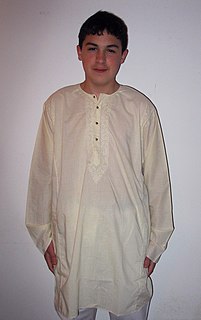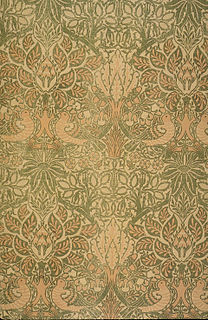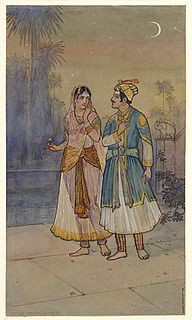
A textile is a flexible material made by creating an interlocking network of yarns or threads, which are produced by spinning raw fibres into long and twisted lengths. Textiles are then formed by weaving, knitting, crocheting, knotting, tatting, felting, bonding, or braiding these yarns together.

Muslin is a cotton fabric of plain weave. It is made in a wide range of weights from delicate sheers to coarse sheeting. It gets its name from the city of Mosul, Iraq, where it was first manufactured. In the 17th and 18th centuries Dacca in Bengal was regarded as producing the finest muslins.

A kurta is a loose collarless shirt worn in many regions of South Asia, and now also worn around the world. Tracing its roots to Central Asian nomadic tunics, or upper body garments, of the late-ancient- or early-medieval era, the kurta has evolved stylistically over the centuries, especially in South Asia, as a garment for everyday wear as well as for formal occasions.

Aida cloth is an open, even-weave fabric traditionally used for cross-stitch embroidery. This cotton fabric has a natural mesh that facilitates cross-stitching and enough natural stiffness that the crafter does not need to use an embroidery hoop.

Double cloth or double weave is a kind of woven textile in which two or more sets of warps and one or more sets of weft or filling yarns are interconnected to form a two-layered cloth. The movement of threads between the layers allows complex patterns and surface textures to be created.

Jamdani is a fine muslin textile produced for centuries in South Rupshi of Narayanganj district in Bangladesh on the bank of Shitalakhwa river. The historic production of jamdani was patronized by imperial warrants of the Mughal emperors. Under British colonialism, the Bengali jamdani and muslin industries rapidly declined due to colonial import policies favoring industrially manufactured textiles. In more recent years, the production of jamdani has witnessed a revival in Bangladesh. Jamdani is typically woven using a mixture of cotton and gold thread.

Broadcloth is a dense, plain woven cloth, historically made of wool. The defining characteristic of broadcloth is not its finished width but the fact that it was woven much wider and then heavily milled in order to shrink it to the required width. The effect of the milling process is to draw the yarns much closer together than could be achieved in the loom and allow the individual fibres of the wool to bind together in a felting process, which results in a dense, blind face cloth with a stiff drape which is highly weather-resistant, hard wearing and capable of taking a cut edge without the need for being hemmed.

The study of the history of clothing and textiles traces the development, use, and availability of clothing and textiles over human history. Clothing and textiles reflect the materials and technologies available in different civilizations at different times. The variety and distribution of clothing and textiles within a society reveal social customs and culture.

A bolt is a piece of cloth woven on a loom or created by a knitting machine, as it is processed, stored and/or marketed. Consequently, its dimensions are highly variable – flexible and dependent upon the manufacturing, machinery, quantity, size, thickness and quality of the product. It is a unit used in manufacturing, transport and inventory. It is also used as a descriptor for wallpaper, which uses different fabrication machinery. Being encompassing, it is by its nature a generic and ambiguous term of convenience and context, used to describe fabric and wallpaper.
Sussi or susi was a term for multicolored striped or checked cloth produced in the Indian subcontinent. Sussi was thin handloom fabric made of cotton, silk, or a blend of the two, with colored warp stripes. Punjab region was known for its production and exports during the Mughal period. Sussi was most often made with red and blue, blue and white, or green and white stripes, but other patterns were also produced. The fabric was exported to England, where sousaes were in great demand in the 18th century.

Piece goods were the textile materials sold in cut pieces as per the buyer's specification. The piece goods were either cut from a fabric roll or produced with a certain length, also called yard goods. Various textiles such as cotton, wool, silk, etc., were traded in terms of piece goods. The prices were determined as per the fabric quality.

Mashru is a woven cloth that is a mix of silk and cotton. Historically, it was a hand-woven satin silk fabric variety found in the Indian subcontinent, and its proper use is described in the 16th-century Ain-i-Akbari.
Ailesham cloth was a fine linen cloth made in England during middle ages.
Seerhand muslin (Seerhand) was a plain weave thin cotton fabric produced in the Indian subcontinent.
Gurrah (garat) was a kind of calico produced in Northeast India during the 18th century. Gurrah was one of the cotton piece goods exported to England and France.

Mulboos khas was a special kind of mulmul cloth made for the King and used for Royal clothing in the Mughal Empire. The Mulboos khas was a kind of first-grade muslin exclusively manufactured in Royal Karkhanas notedly in places like Dacca, Sonargaon, Jangalbaree. Nur Jahan, the empress, was a great admirer of Dacca muslins. Mulboos khas was the finest and most expensive type of muslin, and it was used exclusively in Imperial use.
Tubada was an outer garment for men in India. It was a coat, part of a Hindu's costume in the early 19th century. John Forbes Watson mentions it as a ''wide great coat'' in his book The Textile Manufactures and the Costumes of the People of India, London, 1866.

Jhuna was a fine sheer fabric, an open-weave structure similar to gauze. Jhuna was used primarily in the dresses of the dancers. It was another kind of fine muslin produced in Bengal with other peers such as Buddun khas, kumees, Rang.
Peshgeer is one of the obsolete cotton piece goods produced in the Indian subcontinent. Peshgeer was a type of woven, printed material.
Mirzai (Mirzaee) was a garment similar to a jacket with "long and loose sleeves and open cuffs". It was an under the jacket for males in the Indian subcontinent in the 19th century. Mirzai was made of cotton padding to protect the wearer from the cold.













